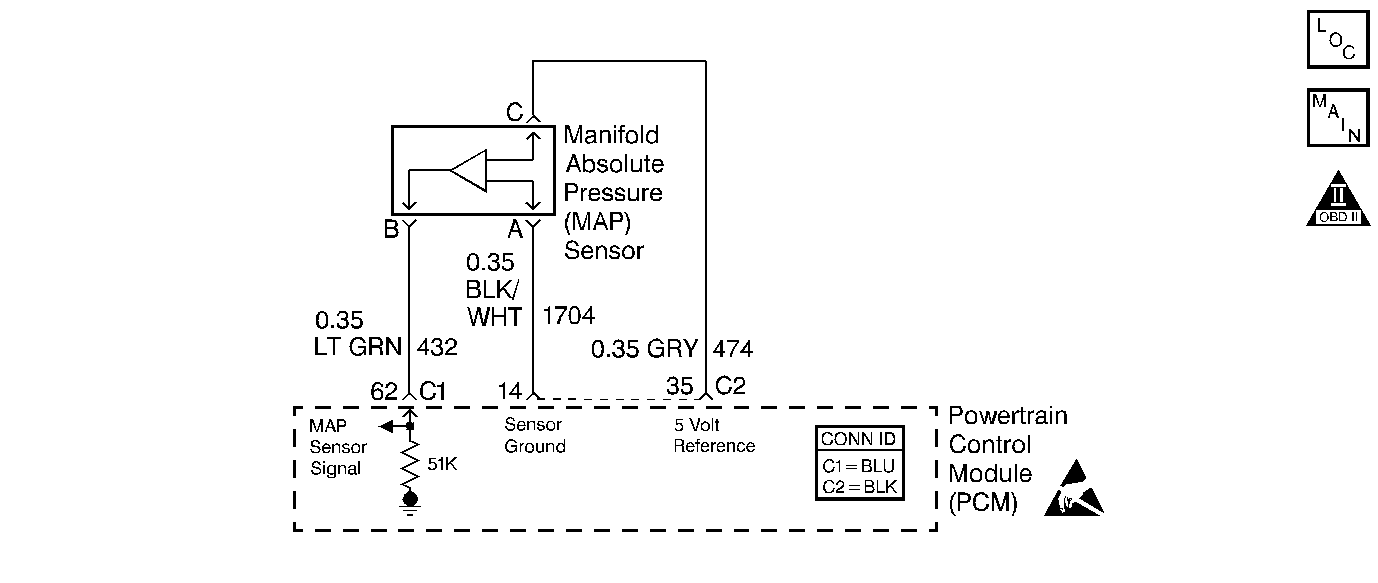
Circuit Description
The Powertrain Control Module (PCM) uses the manifold absolute pressure (MAP) sensor to control the fuel delivery and the ignition timing. The MAP sensor measures the changes in the intake manifold pressure which results from engine load, or intake manifold vacuum, and the RPM changes, and converts these into voltage outputs. The Powertrain Control Module (PCM) sends a 5 volt reference voltage to the MAP sensor. As the manifold pressure changes, the output voltage of the MAP sensor also changes. By monitoring the MAP sensor output voltage, the PCM knows the manifold pressure. A lower pressure, or low voltage, output voltage will be approximately 1.0 to 1.5 volts at idle. Higher pressures, or higher voltage, output voltage will be approximately 4.5 to 4.8 volts at wide open throttle (WOT). The MAP sensor is also used to measure barometric pressure, allowing the PCM to make adjustments for different altitudes.
Conditions for Running the DTC
| • | DTC P0122 or P0123 is not set. |
| • | The engine speed is less than 1000 RPM. |
| Or |
| The engine speed is more than 1000 RPM and the throttle position (TP) sensor is more than 15 percent. |
Conditions for Setting the DTC
| • | The MAP is less than 11.8 kPa. |
| • | The above condition is met for at least 6.25 seconds. |
Action Taken When the DTC Sets
| • | The malfunction indicator lamp (MIL) will illuminate after two consecutive ignition cycles in which the diagnostic runs with the fault active. |
| • | The Powertrain Control Module (PCM) will record the operating conditions at the time the diagnostic fails. This information will be stored in the Freeze Frame and Failure Records buffers. |
| • | A history DTC is stored. |
| • | The coolant fan turns ON. |
| • | The PCM will substitute a fixed MAP value and use throttle position (TP) to control the fuel delivery. The scan tool will not show the defaulted value. |
| • | The PCM will use a fixed BARO value of 90 kPa. |
| • | The vehicle will operate in Open Loop when the vehicle is under 8 km/h (5 mph). The vehicle will operate in Closed Loop when the vehicle is over 8 km/h (5 mph). |
Conditions for Clearing the MIL/DTC
| • | The MIL will turn OFF after three consecutive ignition cycles in which the diagnostic runs without a fault. |
| • | A history DTC will clear after 40 consecutive warm-up cycles without a fault. |
| • | Use a scan tool to clear the DTCs. |
Test Description
The numbers below refer to the step numbers on the diagnostic table.
-
This step determines if DTC P0107 is the result of a hard failure or an intermittent condition.
-
This step determines if the PCM is able to provide a 5 volt reference to the MAP sensor.
-
The scan tool may not display 5 volts. The important thing is that the PCM recognized the voltage as more than 4 volts, indicating that the PCM and MAP signal circuits are OK.
Step | Action | Value(s) | Yes | No |
|---|---|---|---|---|
1 | Did you perform the Powertrain On-Board Diagnostic (OBD) System Check? | -- | Go to Step 2 | |
Does the scan tool display a MAP sensor voltage less than the specified value? | 0.25 V | Go to Step 3 | Go to Step 5 | |
Is the voltage more than the specified value? | 4.7 V | Go to Step 4 | Go to Step 9 | |
Does the scan tool display a MAP sensor voltage more than the specified value? | 4.7 V | Go to Step 6 | Go to Step 7 | |
5 | The DTC is intermittent. Are any additional DTCs stored? | -- | Go to Diagnostic Aids | |
6 | Inspect for a faulty connection at the MAP sensor. Did you find a problem? | -- | Go to Step 12 | Go to Step 11 |
7 | Inspect for an open MAP sensor signal circuit. Did you find a problem? | -- | Go to Step 12 | Go to Step 8 |
8 | Inspect for a short to ground in the MAP sensor signal circuit. Did you find a problem? | -- | Go to Step 12 | Go to Step 10 |
9 |
Did you find a problem? | -- | Go to Step 12 | Go to Step 13 |
10 | Inspect for a faulty connection at the PCM. Did you find a problem? | -- | Go to Step 12 | Go to Step 13 |
11 | Replace the MAP sensor. Refer to Manifold Absolute Pressure Sensor Replacement . Is the action complete? | -- | Go to Step 14 | -- |
12 | Repair the circuit as necessary. Refer to Wiring Repairs or Connector Repairs in Wiring Systems. Is the action complete? | -- | Go to Step 14 | -- |
13 |
Important: Refer to Powertrain Control Module Replacement/Programming . Replace the PCM. Refer to Powertrain Control Module Replacement . Did you complete the replacement? | -- | Go to Step 14 | -- |
14 |
Does the scan tool indicate the diagnostic Passed? | -- | Go to Step 15 | Go to Step 2 |
15 | Does the scan tool display any additional undiagnosed DTCs? | -- | System OK |
